Silybum Marianum, a herb whose scientific last name sounds a lot like my first name Mariama, is a herb after my own heart.
Also called Mary thistle, Marian thistle, Lady’s thistle, Holy thistle, and the wild artichoke, its most popular name is Milk thistle due to the milky sap that oozes from its leaves.
 For over 2000 years this herb has been used as a way to treat issues of the liver, gallbladder, stomach, and intestines.1, 3
For over 2000 years this herb has been used as a way to treat issues of the liver, gallbladder, stomach, and intestines.1, 3
In the late 20th Century, after thousands of years of folk-lore medicine’s testimonials of the great benefits of Milk thistle, especially for the liver, western medicine finally took notice.
In 1986 the German Commission E, a scientific board setup to look into the safety and efficacy of herbs for prescription by medical practitioners, gave the approval for the use of Milk thistle as a treatment for liver diseases such as cirrhosis, hepatitis, and the deposits of fatty substances due to over consumption of alcohol and other toxic chemicals. 2
So how does this amazing herb, which can grow to 6 feet or more, do its work?
Milk thistle has an active ingredient within it called Silymarin. Silymarin is extracted from the seeds of the Milk thistle plant. It is a bioflavonoid complex made up of three isomers:
- Silybin
- Silydianin
- Silychristin
In the human body these flavonoids are beneficial as anti-oxidants: they help to protect the body against free radicals. These flavonoids also help the body to deal with inflammation. They are anti-viral, and also have some properties that help with the fighting of cancer.2, 4
With these amazing flavonoid abilities found in Milk thistle studies have shown that this herb can help reverse damage done to hepatocytes, which are liver cells. It also has the ability to help normalize elevated levels of liver enzymes, which leak into the bloodstream when the liver is inflamed or injured.2
 Milk thistle works directly on the cell membranes of the liver cells by stopping toxins from entering into the cells. It also slows down the absorption of toxins by the liver and instead guides them to the kidneys for excretion. The best example of this is the fact that Milk thistle has the ability to stop poisons from Amanita phalloides, the death cap mushroom, from entering into the liver. Even if treated 36 hours after being poisoned, the administration of silybin, the most active of the three flavonoids in Milk thistle, has helped those poisoned to make a full recovery.2
Milk thistle works directly on the cell membranes of the liver cells by stopping toxins from entering into the cells. It also slows down the absorption of toxins by the liver and instead guides them to the kidneys for excretion. The best example of this is the fact that Milk thistle has the ability to stop poisons from Amanita phalloides, the death cap mushroom, from entering into the liver. Even if treated 36 hours after being poisoned, the administration of silybin, the most active of the three flavonoids in Milk thistle, has helped those poisoned to make a full recovery.2
Milk thistle is also able to stimulate the synthesis of protein in the liver through the enzyme RNA polymerase I. This helps the liver to repair any cells that have  been damaged as well as generate new cells. Research has also found that silybin, the most active component of silymarin, has the same effect in the kidneys.2
been damaged as well as generate new cells. Research has also found that silybin, the most active component of silymarin, has the same effect in the kidneys.2
Just as Milk thistle has an effect on liver and kidney cells, so too does it help to normalise the replication of skin cells by having a direct effect on cAMP and cGMP which are compounds that, among other things, work to govern the multiplication and growth of skin cells.5
With over 300 clinical and laboratory trials already done, research on Milk thistle is still ongoing. 2 There is mounting evidence that Milk thistle may have the ability to help with skin cancer. This makes sense since it has such high flavonoid content.
There are no known contra-indications but those taking medications that raise cytochrome P450 enzymes, which are important for the breaking down of certain medications, should be wary of medication dosages.
Otherwise Milk thistle has been shown to be safe even during pregnancy and has been used to help with lactation.
Sources:
- Murray, N.D, Michael T. “Excerpt: The Healing Power of Herbs.” Liversupport.com. Prima, 1 Jan. 1995. Web. 27 Mar. 2015. <http://www.liversupport.com/the-healing-power-of-herbs/>.
- McCaleb, Robert S., Evelyn Leigh, and Krista Morien. “The Encyclopedia of Popular Herbs, Your Complete Guide to the Leading Medicinal Plants.” Excerpt: The Encyclopedia of Popular Herbs. Prima Health, 1 Jan. 2000. Web. 27 Mar. 2015. .
- “The #1 Researched and Recommended Herb for Liver Health and More!” Milk Thistle. Natural Wellness, 1 Jan. 2015. Web. 27 Mar. 2015. <http://www.liversupport.com/milk-thistle/>.
- Robertson, Sally. “What Are Flavonoids?” <i>News Medical The Latest Developments in Life Sciences & Medicine</i>. 2 Dec. 2014. Web. 27 Mar. 2015. <http://www.news-medical.net/health/What-are-Flavonoids.aspx>.
- Duman RS, Nestler EJ. Functional Roles for cAMP and cGMP. In: Siegel GJ, Agranoff BW, Albers RW, et al., editors. Basic Neurochemistry: Molecular, Cellular and Medical Aspects. 6th edition. Philadelphia: Lippincott-Raven; 1999. Available from: http://www.ncbi.nlm.nih.gov/books/NBK27915/
